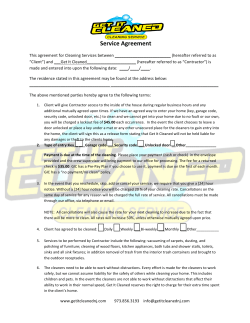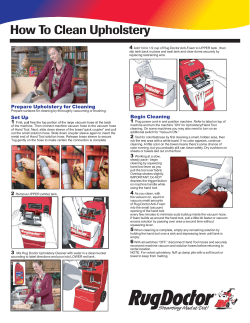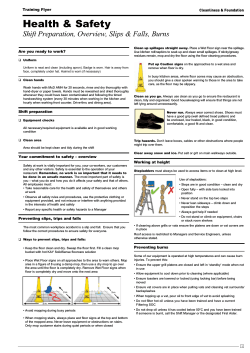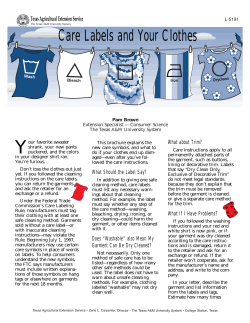
A New Method to Clean Dust From Soiled Work Clothes Objective
No. 509 May 2005 A New Method to Clean Dust From Soiled Work Clothes Objective To develop a quick, safe, and effective method that allows workers at mineral processing operations to clean their dustsoiled clothing periodically throughout the workday. Background Reducing workers' respirable dust exposure to silica and other harmful dusts and contaminants is an ongoing goal in the U.S. mining industry. One area of known worker exposure is from contaminated work clothes. A U.S. Bureau of Mines report documented a number of cases where a tenfold increase in a worker's dust exposure was measured from contaminated work clothes. In these cases, the dust emitted from clothing caused the worker's dust exposure to exceed the permissible exposure limit in less than 2 hours. The most effective way to eliminate this dust source is to have workers clean or change their work clothes. There are two federal regulations that impact the clothescleaning process. The first states that at no time shall compressed air be directed toward a person, but that when compressed air is used, then all necessary precautions shall be taken to protect persons from injury. The second regulation states that compressed air should only be used for cleaning purposes when it is less than 30 psi and used along with personal protective equipment. For the mining industry, by default, the only approved method to perform clothes cleaning is to have workers vacuum their clothes using a HEPA filter system. This is very difficult and time-consuming and, in most instances, not very effective. Most workers would prefer to use a single compressed air hose to blow dust from their work clothes. However, not only is this method prohibited by law, it usually creates a significant dust cloud in the work environment and contaminates coworkers. Approach The clothes-cleaning process was designed within the guidelines of the two federal regulations and provides a much more effective and quicker method for cleaning dust-soiled work clothes. The system consists of four main parts: (1) a cleaning booth, (2) an air reservoir, (3) an air spray manifold, and (4) an exhaust ventilation system. The base dimension of the cleaning booth is 48 by 42 inches. This gives the worker enough space to rotate in front of the air nozzles to perform the cleaning process. Intake air enters the booth through an open grate above the door. It then flows down through the booth and exits on the bottom back wall. An air plenum at the bottom back wall location connects the booth to ductwork that leads to a baghouse dust collector. The air reservoir supplies the required air volume to the air nozzles used in the spray manifold. Either a 120- or 240-gallon reservoir should be used with this system. If it is intended that multiple individuals use the clothes-cleaning process one after another, then the 240-gallon reservoir should be used. This reservoir should be pressurized to 150 psi, located close to the cleaning booth, and hard-piped to the air spray manifold located in the booth. The air pressure is regulated to 30 psi before being directed toward the individual for the clothes cleaning. The air spray manifold is composed of 26 spray nozzles spaced 2 inches apart (Figure 1). The bottom nozzle is located 6 inches from the floor and is a circular designed nozzle for cleaning the person's work boots. This nozzle is used in conjunction with an adjustable ball-type fitting so that it can be directed downward. The other 25 air spray nozzles are flat fan sprays, which lab testing proved to be most effective cleaning at close distances. The 26 air spray nozzles deliver slightly less than 500 ft3/min of air. The average cleaning time with this new clothes-cleaning technique during field testing was about 18 seconds. With the 120-gallon reservoir, there is approximately 22 seconds of air capacity. The 240-gallon reservoir doubles the cleaning capacity and should allow for multiple workers to clean their clothing, one after another. The exhaust ventilation system is connected to the cleaning booth and is capable of creating negative pressure in the booth at all times. This ensures that all of the dust removed from a worker's soiled work clothes is contained within the cleaning booth before being exhausted All workers using this cleaning process are required to wear a half-mask, fit-tested respirator with an N100 filter, hearing protection, and full-seal goggles. The air spray manifold was designed for a 5'10" tall individual, which represents a 50th- shows the cleaning times and effectiveness of the three different techniques. Clearly, the new NIOSH system was much more effective than the other two techniques and at a fraction of the time. Table 1 also shows that the polyester/cotton blend coveralls were cleaned more effectively than the 100% cotton type. Table 1.—Amount of dust remaining on coveralls after cleaning, and cleaning time for cotton and polyester/cotton blend coveralls Cotton Dust Cleaning Cleaning method remaining time, on coveralls, sec grams Vacuuming. . . . . 63.1 398 Air hose . . . . . . . . 68.8 183 New NIOSH system 42.3 17 Polyester/cotton blend Dust Cleaning remaining time, on coveralls, sec grams 45.5 346 48.4 173 21.9 18 Summary Figure 1.—Air spray manifold with 26 nozzles spaced 2 inches apart. percentile male worker. When the person is shorter, the top air nozzles can be covered with deflectors to prevent the air sprays from directly hitting the individual's face. These deflectors were made from 4-in PVC pipe that was cut in half and then into 2-inwide strips. Latches were attached on both sides of these deflectors so they could be locked in either the open or closed position. This clothes-cleaning system was developed under a cooperative research effort between Unimin Corp. and NIOSH. All field testing was done at Unimin's operation in Marston, NC. Field Testing The mineral processing plant where this clothes-cleaning process was field tested had a baghouse with excess capacity. During field testing, the baghouse provided an exhaust air volume of 4,400 ft3/min, creating a negative static pressure of 0.16-in water gauge in the cleaning booth. In lieu of excess baghouse capacity, it is estimated that the minimal exhaust air volume required for this system would be about 1,000 ft3/min, but further testing is needed to verify this value. During field testing, the new clothes-cleaning process with its air spray manifold was compared to the vacuuming system and the single handheld compressed air hose. For this testing, 100% cotton and cotton/polyester blend coveralls were each tested by soiling the coveralls with limestone dust. Table 1 The new NIOSH-developed clothes-cleaning process has been shown to be much more effective in removing dust from a worker's clothes than the methods currently used by workers. This process uses a compressed air nozzle manifold to blow dust from the worker's clothes in an enclosed booth. Since the air exhausted by the dust collector causes the booth to be under negative pressure, no dust escapes to contaminate the work environment or other workers. Test results showed that the NIOSH process cleaned the work clothes 10 times faster and removed up to 50% more dust than the single air hose or vacuuming methods. The average cleaning time with the NIOSH technique was less than 20 seconds. The cost of this clothes-cleaning system was approximately $3,000, excluding the cost of the exhaust ventilation component. For More Information For more information about the new NIOSH clothescleaning system, contact Andrew B. Cecala or Douglas E. Pollock, NIOSH Pittsburgh Research Laboratory, Cochrans Mill Rd., P.O. Box 18070, Pittsburgh, PA 15236–0070; phone: 412–386–6677 or 412–386–6863, respectively; fax: 412–386– 4917; e-mail: ACecala@cdc.gov or DEPollock@cdc.gov, respectively. To receive other information about occupational safety and health topics, call 1–800–35–NIOSH (1–800–356–4674), or visit the NIOSH Web site at www.cdc.gov/niosh Mention of any company name or product does not constitute endorsement by the National Institute for Occupational Safety and Health. DHHS (NIOSH) Publication No. 2005–136
© Copyright 2025
















